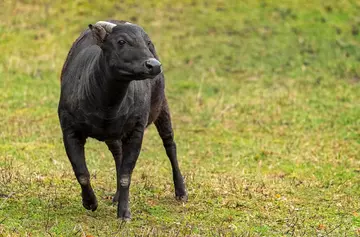
Smallest wild cow
Anoa are the smallest of all cattle species, and they are only found in the islands of Sulawesi and Buton off the southeast coast of Indonesia. Despite being a dwarf buffalo and the smallest cattle species, they can still reach up to 300kg in weight at up to a metre tall at the shoulder. This makes them the largest of all endemic mammals in the island of Sulawesi.
There are likely two species of anoa and both are endangered with only around 2500 adults remaining, the lowland anoa and mountain anoa. We have lowland anoa at the Zoo, which are slightly larger and have less bushy fur than mountain anoa, but some scientists are still unsure if they can be counted as two separate species.

Our ZSL scientists have carried out research on anoa out in the wild, surveying their populations and helping map out conservation work for the species. Together with collaborators our scientists also attempted to answer how many species there are once and for all, but sadly after assessing all the evidence we weren't able to come to a definitive conclusion.
Not much is known about anoa behavior in the wild because they are so elusive, so being able to see them at the Zoo is a real privilege. By working closely with anoa at the Zoo, we can provide insights which aren't possible to get in the wild.
What do anoas eat?
Anoas have been observed eating 146 different species of plants out in the wild, and mainly eat flowering plants but also like to eat fruits and figs.
The food they eat usually has a low mineral content, so they like to drink at mineral licks and springs to make up for this. Although anoa are solitary, they can be seen gathering at salt licks and wallows.
Anoa threats
Anoas biggest threat is hunting for food by local people, as people are often unaware of their protected status and often rely on the forests for food. The next biggest risk to anoas is habitat loss due to agriculture and gold mines, for example the loss of lowland forest between 1985 and 1997 has been estimated to be 89%.
Anoa populations are now split off from each other which is bad news for the future of the species, with no single area having any more than 250 adults.
Anoa conservation
Protecting anoas from hunting and habitat loss is the most important step towards protecting anoas. Genetic studies are important to securing a future for anoa to determine the number of species and ensure population isolation doesn't cause a lack of genetic diversity. Future conservation work is likely to focus on connecting their fragmented habitats.
Animals at Monkey Forest
Sulawesi crested macaque
Sulawesi crested macaques might not look like a monkey, but they actually have a vestigial tail that's just 2cm long.
Anoa
A dwarf buffalo, anoas are the smallest of all cattle species and our scientists have been working to protect them.
